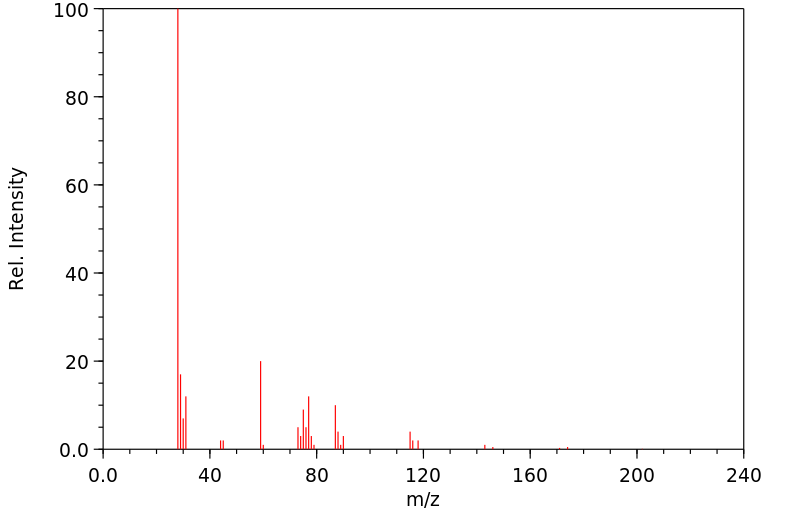Cobalt, tetracarbonylsilyl- | 14652-62-1
中文名称
——
中文别名
——
英文名称
Cobalt, tetracarbonylsilyl-
英文别名
——
CAS
14652-62-1
化学式
C4H3CoO4Si
mdl
——
分子量
202.144
InChiKey
GNLQHEYIJVVRMJ-UHFFFAOYSA-N
BEILSTEIN
——
EINECS
——
-
物化性质
-
计算性质
-
ADMET
-
安全信息
-
SDS
-
制备方法与用途
-
上下游信息
-
文献信息
-
表征谱图
-
同类化合物
-
相关功能分类
-
相关结构分类
计算性质
-
辛醇/水分配系数(LogP):None
-
重原子数:None
-
可旋转键数:None
-
环数:None
-
sp3杂化的碳原子比例:None
-
拓扑面积:None
-
氢给体数:None
-
氢受体数:None
反应信息
-
作为反应物:描述:参考文献:名称:硅过渡金属化合物。第三部分 甲硅烷基四羰基钴和甲硅烷基五羰基锰与氮和磷的路易斯碱的反应摘要:甲硅烷基四羰基钴和甲硅烷基五羰基锰与三甲胺和吡啶(py)形成1:2加合物,与2,2′-联吡啶(bipy)形成1:1加合物。推断出其稳定性可能存在以下顺序:SiH 3 Co(CO)4 > SiH 3 Mn(CO)5和NMe 3 > py〜bipy。铱的固体加合物的研究表明的离子结构,硅烷(SiH 3,2B)+ [M(CO)Ñ ] - 。不像的SiH 3的Mn(CO)5,的SiH 3的Mn(CO)5,2PY发生反应容易地用HCl,得到的SiH 3氯。氨与气态SiH 3反应Co(CO)4和SiH 3 Mn(CO)5产生(SiH 3)2 NH及其分解产物;PH 3和PF 3在室温下均不反应。DOI:10.1039/j19690001920
-
作为产物:描述:参考文献:名称:Gmelin Handbuch der Anorganischen Chemie, Gmelin Handbook: Co: Org.Verb.1, 1.1.4.5.2.1.1, page 115 - 118摘要:DOI:
文献信息
-
Silicon–transition-metal compounds. Part I. Silyltetracarbonylcobalt and related compounds作者:B. J. Aylett、J. M. CampbellDOI:10.1039/j19690001910日期:——di-iodosilane react with NaCo(CO)4 in ether at low temperatures to give silyltetracarbonylcobalt, SiH3Co(CO)4, and silylenebis(tetracarbonylcobalt), SiH2[Co(CO)4]2, respectively. Physical properties of both compounds are reported, together with i.r., mass, and n.m.r. spectra of SiH3Co(CO)4. Pyrolysis of gaseous SiH3Co(CO)4 at 120° yields H2, CO, SiH4, and a dark-coloured inert solid; some HCo(CO)4 is also present碘硅烷和二碘硅烷在低温下与NaCo(CO)4在乙醚中反应,分别得到甲硅烷基四羰基钴,SiH 3 Co(CO)4和亚甲撑双(四羰基钴),SiH 2 [Co(CO)4 ] 2。报告了这两种化合物的物理性质,以及SiH 3 Co(CO)4的ir,质量和nmr光谱。气态SiH 3 Co(CO)4在120°上热解产生H 2,CO,SiH 4和深色惰性固体。一些HCo(CO)4在早期也存在。推断出固体产物的化学计量学和可能的交联聚合物性质,并概述了其金属涂层性能。SiH 3 Co(CO)4中的Si-Co键被HX(X = F,Cl,O / 2)破坏,得到SiH 3 X和HCo(CO)4,也被HgX 2(X = Cl,I ),得到SiH 3 X和Hg [Co(CO)4 ] 2。SiH 2 [Co(CO)4 ] 2的行为类似。没有将CO插入Si-Co键中;PPh 3与SiH 3 Co(CO)4缓慢反应取代CO并可能产生反式-SiH
-
Chemical vapour deposition of transition-metal silicides by pyrolysis of silyl transition-metal carbonyl compounds作者:Bernard J. Aylett、Howard M. ColquhounDOI:10.1039/dt9770002058日期:——Pyrolysis of [Co(CO)4(SiH3)], [Fe(CO)4(SiH3)2], and [Mn(CO)5(SiH3)] at 773 K in a flow system affords the transition-metal silicldes CoSi, β-FeSi2 and MnSi–Mn5Si3 respectively. Static pyrolysis of [Mn(CO)5(SiH3)] gives only amorphous solid products which contain, in addition to metal and silicon, appreciable quantities of carbon, hydrogen, and oxygen.
-
Chemical vapour deposition of metals and metal silicides on the internal surfaces of porous silicon作者:D.G. Anderson、N. Anwar、B.J. Aylett、L.G. Earwaker、M.I. Nasir、J.P.G. Farr、K. Stiebahl、J.M. KeenDOI:10.1016/0022-328x(92)83450-v日期:1992.8Cobalt, cobalt monosilicide and rhenium thin films have been deposited on the internal walls of both n- and p-type porous silicon (PS) by metallo-organic chemical vapour deposition (MOCVD) at moderate temperatures and low pressure. Characterisation of the films by Rutherford Back-Scattering (RBS) showed penetration of Co, CoSi and Re into the pores to a depth of at least 2 mum, the concentration decreasing with increasing depth; NRA light element analysis revealed that substantial levels of oxygen and, to a lesser extent, carbon were present in the films.
-
Gmelin Handbuch der Anorganischen Chemie, Gmelin Handbook: Co: Org.Verb.2, 2.1.1.2.5, page 8 - 16作者:DOI:——日期:——
-
Gmelin Handbuch der Anorganischen Chemie, Gmelin Handbook: Co: Org.Verb.1, 1.1.4.5.2.5.1, page 129 - 130作者:DOI:——日期:——
表征谱图
-
氢谱1HNMR
-
质谱MS
-
碳谱13CNMR
-
红外IR
-
拉曼Raman
-
峰位数据
-
峰位匹配
-
表征信息
同类化合物
黄原酸环癸酯
高纯三甲基锑
顺式-二氯二(环丙胺)铂(II)
顺式-二氯二(乙二胺)氯化铑(1+)
顺式-二(环己基丁氨合)二氯铂(II)
顺式-二(异丙基氨合)二氯铂(II)
顺式-(2-氨基甲基-1-环戊基氨合)二氯铂(II)
顺二氯二羰基铂(II)
顺-二氯双(乙二胺)氯化铱
雷(酸)汞[含水或水加乙醇≥20]
间碳硼烷-9-硫醇
镍,加合(7:2)钪
镉二(二戊基二硫代氨基甲酸盐)
镁,溴-6-庚烯基-
manganese carbide
butyl manganese bromide
锡烷,氯二环己基-
锡四丁醇
锑,(1:1)混合物和钪
锌叔-丁氧化物
锌,溴-1-丙烯基-,(E)-
锇,加合(2:1)钪
锆酸四丁酯
锂丁酯
锂4-异丙氧基-2-甲基-丁烷-2-醇
锂1-丁醇
锂(三氟甲基)乙炔化物
锂(3-氨基丙基)酰胺
铼五羰基碘化物
铼五羰基
银(I)2-羟基乙烷-1-硫醇盐
铯三氯三羰基锇
铬三乙二胺
铬,五羰基(环己胺)-,(OC-6-22)-
铬,二(乙酰腈)二氯-
铝,加合(3:1)钪
铜-乙二胺络合物
铜(II)乙二胺
铜(I)乙炔化物
铍,环戊-1,3-二烯,溴化
铊N,N-二正丁胺
铊,甲氧基二甲基-
铂(2+)二氯化3-甲基丁烷-1,2-二胺(1:1)
铁(3+)三(1-丁醇)
铁(2+)1,1'-(硫烷二基二-1,1-乙二基)二-2,4-环戊二烯化
铀,三甲基-
钾,[三(三甲基甲硅烷基)甲基]-
钴四异硫氰酸酯
钴,乙烷-1,2-二胺
钠辛基二硫代氨基甲酸酯







